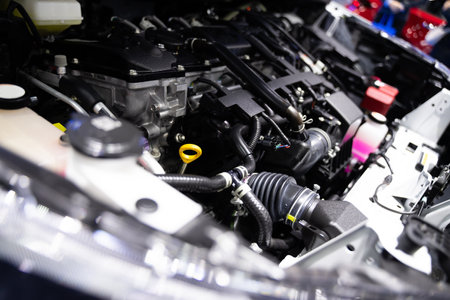1. Introduction to Exhaust Crossover Designs
When it comes to upgrading the exhaust system on American muscle cars and performance vehicles, enthusiasts are often faced with the choice between an X-pipe and an H-pipe. Both of these exhaust crossover designs play a crucial role in how your car sounds and performs, but they have different characteristics that can make one a better fit than the other depending on your goals.
What Are X-Pipes and H-Pipes?
An X-pipe and an H-pipe are both sections of pipe that connect the two sides of a dual exhaust system. Their main job is to help balance the exhaust gases flowing from each bank of cylinders in a V-style engine. This crossover not only affects the sound of your car but also its horsepower and torque output.
X-Pipe
The X-pipe gets its name because the pipes cross over each other in the shape of an “X.” This design allows exhaust gases from both banks to merge smoothly, which helps improve scavenging (the process of clearing out spent exhaust gases so fresh air and fuel can enter the cylinders). This often results in more high-end horsepower and a smoother, higher-pitched exhaust note.
H-Pipe
The H-pipe, on the other hand, connects the two sides with a straight horizontal section, forming an “H” shape. It provides a path for pressure waves to equalize between the two banks, which can help boost low-end torque and produce a deeper, more classic muscle car sound.
Role in American Muscle and Performance Cars
Both X-pipes and H-pipes have become staples in American car culture, especially among those looking to squeeze extra performance or signature sound from their V8 engines. Whether you drive a Mustang, Camaro, Challenger, or any other American muscle icon, choosing the right crossover pipe is an important step in customizing your rides personality.
Quick Comparison Table: X-Pipe vs. H-Pipe
| Feature | X-Pipe | H-Pipe |
|---|---|---|
| Exhaust Note | Smoother, higher-pitched | Deeper, classic muscle sound |
| Performance Focus | High-end horsepower | Low-end torque |
| Common Use | Modern performance builds | Traditional muscle cars |
| Design Shape | “X” crossover merge | “H” horizontal connection |
Understanding these basics will help you make an informed decision about which exhaust crossover design might be right for your own vehicle.
2. How X-Pipes Work
What Is an X-Pipe?
An X-pipe is a type of exhaust crossover pipe that’s shaped like the letter “X.” It connects the two sides of a dual exhaust system, allowing exhaust gases to merge and flow through both pipes more efficiently. You’ll usually find X-pipes installed underneath the car, between the headers and the mufflers.
Typical Placement of an X-Pipe
| Component | Placement |
|---|---|
| X-Pipe | After the exhaust headers, before the mufflers |
| H-Pipe (for comparison) | Similar location, but with a straight crossbar connection |
How Does an X-Pipe Influence Exhaust Flow?
The unique “X” shape of this pipe design encourages exhaust pulses from both banks of cylinders to blend together smoothly. This merging effect helps equalize exhaust pressure, reducing backpressure and improving scavenging—the process where spent gases are pulled out of the cylinder by the velocity of following pulses. As a result, your engine can breathe better at higher RPMs, which can mean more horsepower and a quicker throttle response.
Key Benefits of X-Pipes on Performance
- Improved High-End Power: By smoothing out the flow, X-pipes generally boost horsepower at higher engine speeds.
- Better Exhaust Scavenging: The merging effect pulls exhaust gases out more efficiently.
- Smoother Flow Path: Less turbulence compared to other designs, helping reduce unwanted backpressure.
The Sound of an X-Pipe System
If you’re into how your ride sounds, here’s what you need to know: X-pipes typically produce a higher-pitched, smoother exhaust note compared to H-pipes. Think of it as a European sports car sound—more refined and less of that deep, burbling rumble you get from muscle cars. Many American performance enthusiasts like this sound for street or track builds where a modern tone is preferred.
X-Pipe Effects Summary Table
| Feature | X-Pipe Effect |
|---|---|
| Performance Focus | High RPM power gains |
| Exhaust Note | Smoother, higher-pitched tone |
| Backpressure Reduction | Significant at high RPMs |
| Best For | Modern builds, racing applications |
![]()
3. How H-Pipes Work
Understanding the H-Pipe Layout
An H-pipe is a type of exhaust crossover that connects both sides of a dual exhaust system with a horizontal pipe, forming an “H” shape. This simple design is often found in American muscle cars and classic hot rods. The H-pipe is typically installed closer to the engine, before the mufflers, allowing some of the exhaust gases to flow between both banks of cylinders.
Unique Characteristics of H-Pipes
| Feature | Description |
|---|---|
| Design Shape | Horizontal connector forming an “H” with two exhaust pipes |
| Placement | Usually positioned near the headers or mid-pipes |
| Installation Complexity | Straightforward; fits most traditional dual exhaust setups |
| Common Vehicles | Classic muscle cars, trucks, and V8-powered vehicles |
Effects on Exhaust Scavenging and Performance
The main job of an H-pipe is to help balance exhaust pulses from each bank of cylinders. When one side of the engine pushes out exhaust gas, some pressure escapes through the connecting pipe to the other side. This helps relieve backpressure, but not as aggressively as other crossover designs like X-pipes. The result is a modest improvement in low-end torque without dramatically changing overall horsepower.
Performance Impact Table
| Aspect | Effect with H-Pipe |
|---|---|
| Torque (Low RPM) | Slightly improved, smoother delivery at lower speeds |
| Horsepower (High RPM) | No significant increase over true duals or X-pipes |
| Backpressure Reduction | Mild reduction, better than no crossover but less than X-pipe |
| Exhaust Scavenging Efficiency | Moderate improvement; less efficient than X-pipe at high RPMs |
The Signature Sound of H-Pipes: Classic American Rumble
If you love that deep, old-school rumble commonly associated with vintage Mustangs or Camaros, the H-pipe delivers. It produces a low-frequency, throaty sound that many American car enthusiasts crave. Unlike the raspier tone of X-pipes, H-pipes keep things mellow and muscular—perfect for those who want their ride to sound as tough as it looks.
4. Performance Comparison: Horsepower and Torque
When it comes to choosing between an X-Pipe and an H-Pipe for your American muscle or performance car, most drivers want to know which setup delivers the best bang for their buck in horsepower and torque. Let’s break down how each exhaust crossover design stacks up in real-world performance and why these differences matter in American car culture.
X-Pipe vs. H-Pipe: The Numbers That Matter
Both X-Pipes and H-Pipes are designed to balance exhaust pulses between your engine’s banks, but they do it in slightly different ways that impact performance. Here’s a simple comparison:
| Feature | X-Pipe | H-Pipe |
|---|---|---|
| Horsepower Gains | Higher peak horsepower, especially at high RPMs | Slightly less peak horsepower compared to X-Pipe |
| Torque Delivery | Smoother torque curve, often less low-end torque boost | Strong low-end and mid-range torque, great off the line |
| Sound Profile | Raspy, exotic, higher-pitched note (think modern muscle) | Deep, throaty, classic American V8 rumble |
| Best For | Track days, high-revving builds, max horsepower seekers | Cruising, street driving, old-school muscle fans |
What Does This Mean for American Car Enthusiasts?
If you’re all about quarter-mile times or love the adrenaline of wide-open throttle pulls on the highway, an X-Pipe might be your go-to. It’s popular with Mustang GT, Camaro SS, and Charger/Challenger owners who crave every last bit of top-end power. On the flip side, if you enjoy burnouts at the local car meet or just want that unmistakable V8 growl when cruising Main Street, an H-Pipe fits right in with traditional American car culture.
Dyno-Tested Differences You Can Feel
Real dyno tests often show X-Pipes giving a 5-10 horsepower bump over H-Pipes at higher RPMs on most V8 engines. However, H-Pipes can provide a more noticeable increase in torque right where you feel it during daily driving—perfect for stoplight launches and city cruising. Both designs can give you gains over a stock system, but your choice should match how you drive and what sound gets your heart racing.
5. Sound Differences and Driving Experience
When it comes to exhaust crossover designs, the way your car sounds and feels behind the wheel can make all the difference. In the U.S., car enthusiasts often have strong opinions about how their vehicles should sound—some prefer a deep, rumbling tone, while others love a high-pitched, aggressive roar. Let’s break down how X-pipes and H-pipes stack up in terms of exhaust note, volume, and overall driving experience.
Exhaust Note: Tone and Character
| Crossover Type | Typical Sound | Common Preferences |
|---|---|---|
| X-Pipe | Higher-pitched, smoother, more refined “European” or exotic sports car sound | Popular among drivers looking for a modern, race-inspired exhaust note |
| H-Pipe | Deeper, throatier, classic American muscle car rumble | Loved by fans of vintage V8s and traditional muscle car soundtracks |
Volume: Loudness on the Road
X-pipes tend to produce a slightly higher overall volume at higher RPMs because they promote better scavenging and more efficient flow. This results in a sharper and crisper exhaust note that really comes alive when you step on it. H-pipes, meanwhile, usually mellow out some of the harshness, offering a fuller but less aggressive sound profile at cruising speeds. Many American drivers who enjoy long highway trips appreciate the reduced drone from an H-pipe setup.
Behind the Wheel: Feel and Feedback
The way each pipe changes your driving experience goes beyond just sound. X-pipes are known for smoothing out power delivery at high RPMs, which makes acceleration feel more linear—a characteristic often associated with performance-oriented driving. On the other hand, H-pipes maintain that old-school muscle feel with strong low-end torque and a punchy response when you hit the gas. This can make stoplight launches and low-speed cruising feel especially satisfying for those who love raw American muscle cars.
Which One Matches Your Style?
If you’re after that iconic “muscle car” growl and want your ride to sound like a true Detroit classic, an H-pipe is likely your best bet. If you’re into performance cars with a sharper, sportier edge—think road racing or modern supercars—the X-pipe could be exactly what you’re looking for. Ultimately, the choice often comes down to personal taste and how you want your car to represent your style on American roads.
6. Choosing the Right Exhaust Crossover for Your Ride
Picking between an X-pipe and an H-pipe isn’t just about numbers or dyno charts—it’s about matching your exhaust setup to your driving style, your vehicle build, and what you want out of your ride. Whether you’re looking to cruise Main Street, tear up the drag strip, or just enjoy a killer sound every time you hit the gas, here’s how each crossover design fits different American car enthusiast goals.
Which Pipe Fits Your Driving Style?
| Driving Style | X-Pipe | H-Pipe |
|---|---|---|
| Daily Driver/Street | Smoother tone, more high-end power for spirited on-ramps and open roads | Classic muscle car rumble, stronger low-end torque for stop-and-go traffic |
| Track/Racing | Better scavenging and top-end horsepower—great for high RPM runs | Decent performance boost but tends to favor mid-range power over peak numbers |
| Show/Weekend Cruiser | Crisp, raspy exhaust note that stands out at car meets and shows | Deep, throaty sound that’s pure Americana—perfect for classic builds |
Vehicle Build Considerations
- Classic Muscle Cars (Mustang, Camaro, Charger): H-pipes complement V8s from the ‘60s and ‘70s, keeping the exhaust note traditional and beefy.
- Modern Performance Cars (Corvette, Challenger, Mustang GT): X-pipes help maximize horsepower gains from modern engines with higher rev limits.
- Trucks & SUVs (F-150, Silverado): H-pipes deliver grunt down low for towing and off-the-line punch; X-pipes can liven things up if you want sportier driving.
- Tuned Imports & LS Swaps: X-pipes bring out the high-revving character and cleaner sound of modern swaps or turbo builds.
Personal Goals: What Matters Most to You?
| Your Goal | X-Pipe Advantage | H-Pipe Advantage |
|---|---|---|
| Louder, unique sound | Crisper, higher-pitched rasp—less drone inside the cabin | Bass-heavy rumble that turns heads at idle or low speed |
| Maximum power at high RPMs | Helps with scavenging for better peak horsepower—great for racing or aggressive street use | Keeps torque strong in the lower RPMs—ideal for city driving or towing needs |
| Nostalgic vibe/period-correct look and sound | Modern feel—not typically chosen for retro authenticity | The go-to choice for vintage vibes and authentic muscle car experiences |
| Easy installation/flexibility with upgrades later on | Might require more precise alignment; some kits are bolt-in but may need welding for best fitment | Simpler design makes installs straightforward; works well with most aftermarket mufflers/tips |
What Do Most American Enthusiasts Choose?
If you want a deep growl that says “classic Detroit iron,” go with an H-pipe. If you’re building a modern powerhouse or crave that crisp race-inspired note, reach for an X-pipe. Either way, both setups offer real benefits—you just have to match them to how you drive and what makes you smile every time you start your engine.
7. Conclusion
When it comes to choosing between an X-pipe and an H-pipe for your exhaust system, it really depends on what you want from your ride. Both designs have their strengths, and understanding these differences can help you make the best choice for your car and driving style.
Key Takeaways: X-Pipe vs. H-Pipe
| Feature | X-Pipe | H-Pipe |
|---|---|---|
| Performance Focus | High-RPM horsepower, more top-end power | Low-to-mid RPM torque, better low-end response |
| Sound Profile | Smoother, higher-pitched, exotic or European sports car tone | Deeper, old-school muscle car rumble |
| Best For | Track use, spirited street driving, modern builds | Cruising, classic muscle cars, daily drivers wanting strong pull off the line |
Making the Right Choice
If you crave that raspy, race-inspired sound and want to squeeze out every bit of horsepower at higher RPMs, the X-pipe is a solid pick. On the other hand, if you love the traditional American V8 rumble and want extra torque when taking off from a stoplight, the H-pipe might be just right for you.
Your Driving Style Matters Most
No matter which crossover you choose, both options offer unique benefits that suit different needs and preferences. Whether youre building a weekend warrior or just want your daily driver to sound and perform its best, understanding how each design affects performance and tone will help you get the most out of your exhaust system.


